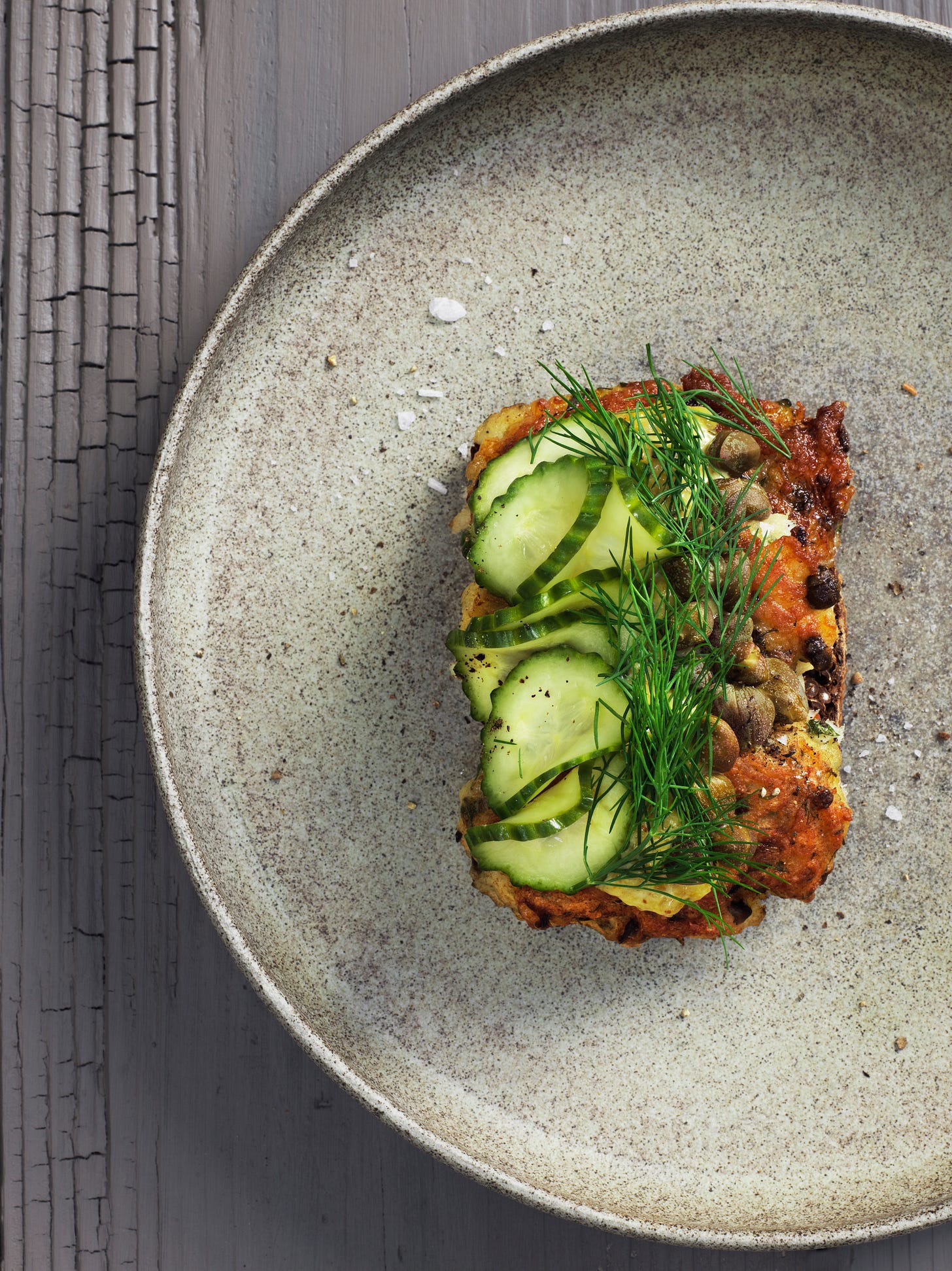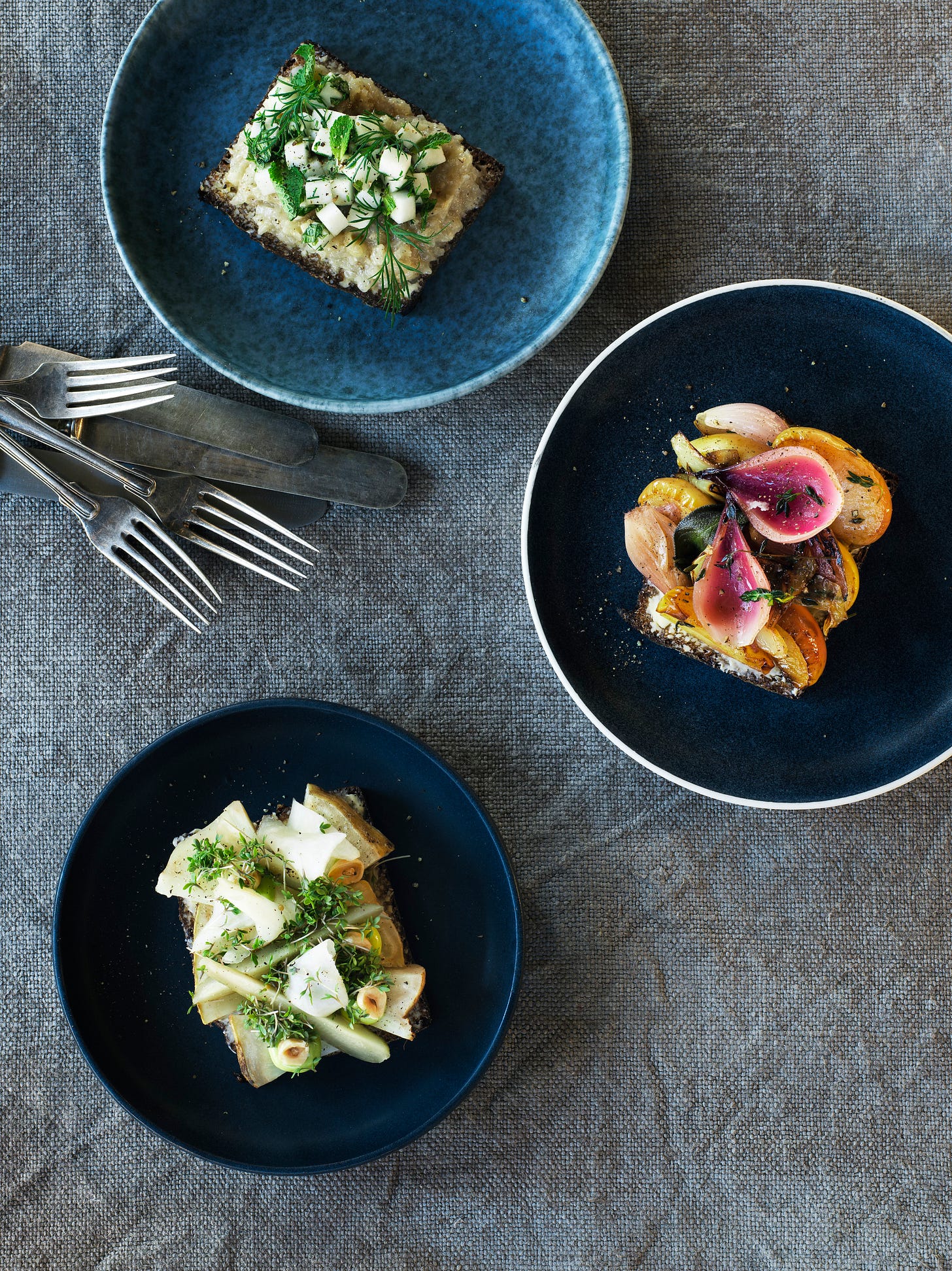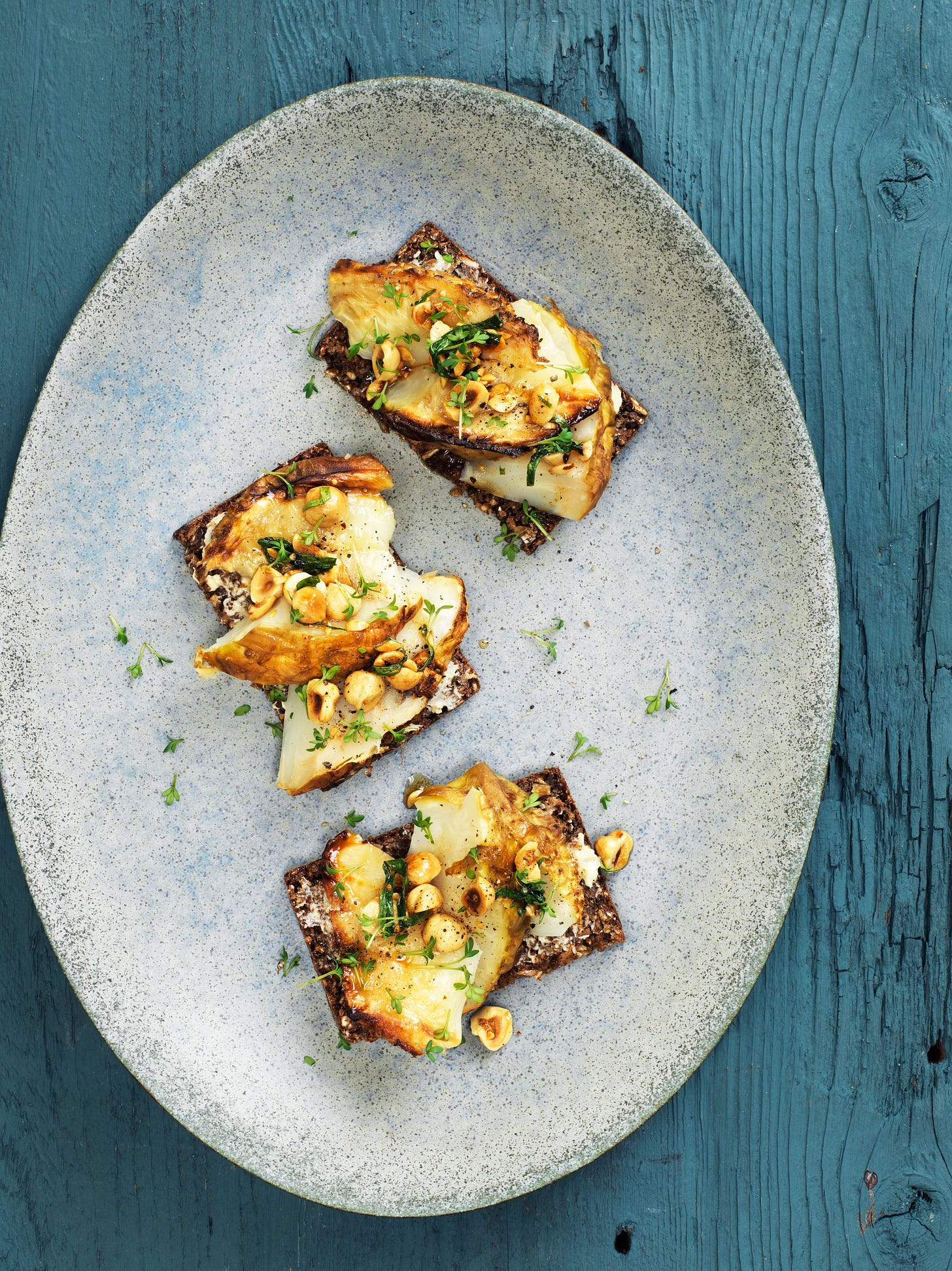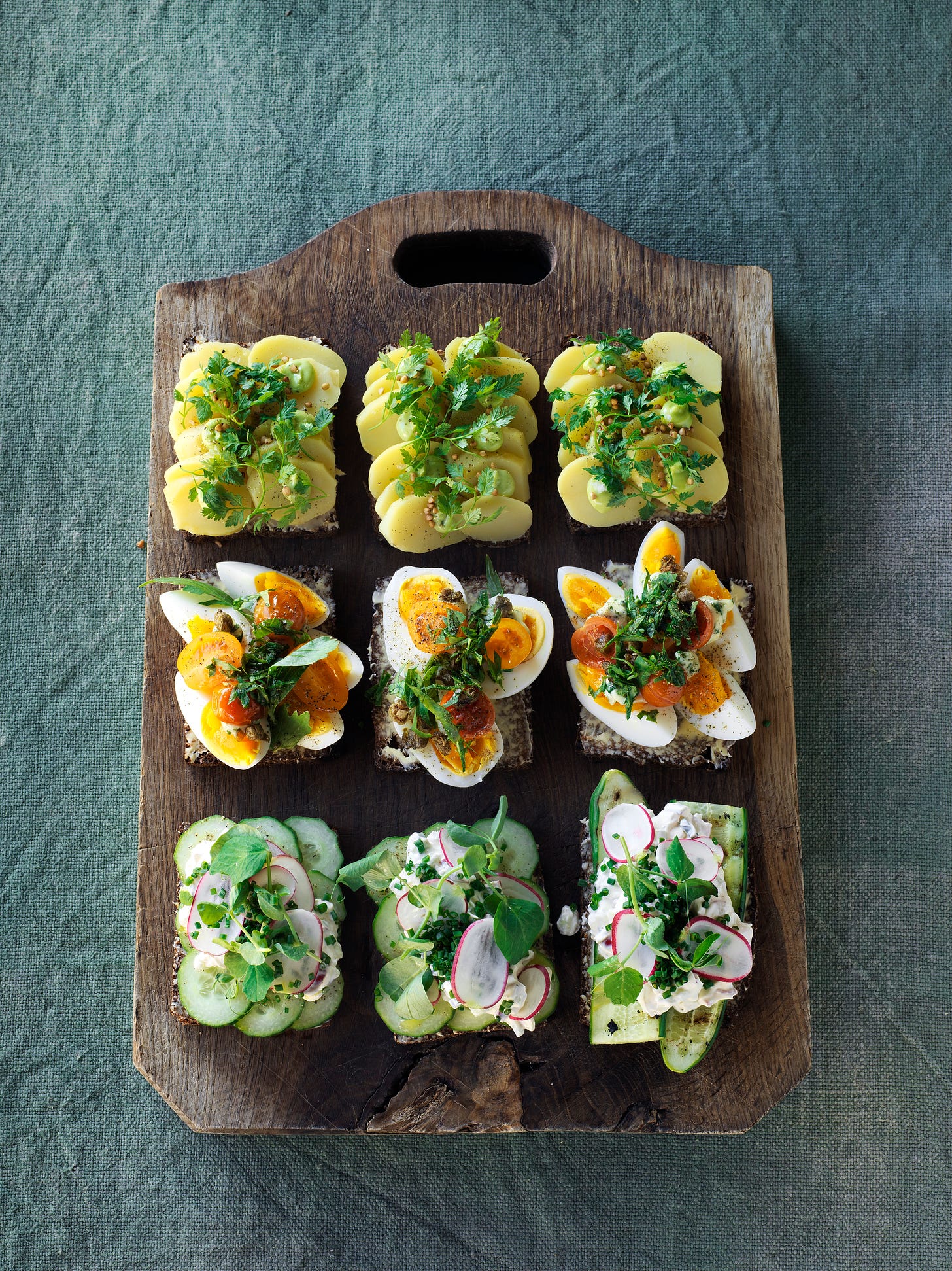Smørrebrød – The Danish lunch
Cooking and baking is a way to connect with a new space. So, no matter where I have lived in the world, I have baked rye bread, the base of smørrebrød. That ritual has made me feel at home.
All photos: Columbus Leth
Last week I wrote about home. I am trying to find out what it means, now that I am setting up home in a new country, were both the light, the landscape, and the daily rhythm is new. One thing I do know, is that food makes me feel connected. No matter where in the world I have lived, I have baked rye bread.
The task of finding rye flour and cracked rye for baking the rye bread has gotten me into co-ops and connected me with people who are into baking, and with bakers who led me to the right millers producing the right stone ground rye flour. I met people, got new friends but also a sense of belonging because, no matter what, I would find a way to bake this one bread that I have been eating all my life. Taking my sourdough starter and mixing it with flour, salt and water, there will be bread. That has been a life assurance.
RYE BREAD
So, this very traditional Danish rye bread has travelled with me. Once, my sister sent the sourdough starter to Washington D.C because I had forgotten it in my fridge in Copenhagen, and it survived. I brought the sourdough starter with me here to Italy, where my husband bakes the rye bread every week. You’ll find the recipe here on my Substack.
I would like to share a bit of the smørrebrød’s history, how you can make it at home, and what are the hidden rules. Also, some recipes of the smørrebrød I make, which mostly is with vegetables. And a list of where to go to eat smørrebrød in Copenhagen.
How to make smørrebrød or invite people over for the smorgasbord?
To make smørrebrød, you’ll need a few basic ingredients, all of which would be a given in most Danish cupboards or refrigerators. Some are homemade, other are bought readymade. Of course, it is possible to buy rye bread, but nothing beats the home baked one. Rye bread is in Denmark a stable like milk, butter and cheese.
Most crucial: smørrebrød begins with a piece of rye bread. You start with a slice of the bread and then you spread some salted butter on it, a thin layer and evenly, so all corners of the bread are covered.
Then there are the different toppings like boiled potatoes, tomatoes, boiled eggs, different kinds of prepared fish. There are also meats such as the frikadelle, which is quite easy to make, liver pâté, cured and roasted meats.
The condiments and all the pickled stuff and the mayonnaise can easily be bought in shops, but taste is so much better if home-made. That is of course a choice and, if not living in Denmark, some of the things can be difficult to find, like fried onions available, however, in Ikeas and many Chinese food shops.
Making a piece of smørrebrød at home is not difficult. Think about it like LEGO, it is about putting bricks together in the right way, then build your you own open sandwich, that is smørrebrød. So, essentially, good bread, salted butter and then a selection of things to eat on the bread.
THE UNWRITTEN RULES
Must food cultures have rules; they are often unwritten and in some ways almost hidden to the outsider and not spoken about. You learn about them when growing up, not by being told as such, it is more subtle, it is more like unconscious observing.
The question is, then, what the unwritten rules are in the tradition of making and eating smørrebrød. I will try to bring them out into the open to the best of my ability, but it can only be as I learned them from my family. There may be different unwritten rules in other families in other regions that I am not aware of.
To start with the bread: primarily it should be rye bread, with a few exceptions though. No rules without exceptions. The rye bread should be cut in relatively thin slices. Then there is the question of butter. It must be salted butter. However, I have adjusted this rule since the years of my mormor’s generation: I do not always need butter. So, my rule is that there must be butter if the topping can soak the bread, or if it is important for the flavour. Examples could be shrimp, or fig spread, chocolate, or raisin – something where the salt in the butter balances the sweet in the toppings. Butter or not butter is also a very personal matter, and a lot of people will disagree with me.
Next, there must be a main topping and then a combination of condiments to add on. A specific combination must have at least 3 of the following flavour components: salt, sweet, sour, bitter, and umami. For texture, there should be both something soft and crunchy. If the meat is fatty, the topping should be a light sweet-and-sour topping. If the meat is lean, there should be more fat in the topping, like mayonnaise. So, in both flavour and texture you are going for the balance.
Smørrebrød must look appetizing. There should be more than 1 colour, and some herbs to decorate with. Small crest is the most common herb. I grow my own, which is easy in your windowsill. Place the seeds on some cotton, it will grow for 3-5 days, and you have mini crest in your kitchen.
There are also trends in smørrebrød. 30 years ago, it came with little bread, too much topping, and lots of weird decoration you had to set aside before eating. Now it’s different. Bread is very important and the main ingredient, and everything on the bread must be part of what you eat.
Season also used to play a big role, so tomato with mayonnaise and chives or smoked mackerel with chives and scramble eggs were in summer, boiled cold potatoes mostly in summer, but now you will find all of them in Copenhagen all year round.
Finally, you must eat smørrebrød in a certain order if you are going for the smorgasbord or have it served in a restaurant:
Always herring first.
Then salmon or other fish dishes.
Then meat or vegetables.
If you are having cheese, always in the end.
You yourself can elaborate on the specific combinations. There’s no reward for being boring. So, new and interesting combinations are always welcome. Also, as you sit at the smorgasbord and everybody are composing their own smørrebrød, you may sit and observe, looking for ideas for interesting combinations. Danes do enjoy inviting foreigners over for a smørrebrød lunch and not let them in on the unwritten rules, and then laugh before they help them out. It’s not cruel, just Danish humour.
Still, there are things, which are just not done: combining herring and meat, or any fish and meat for that matter, except maybe for bacon as a cross over; salmon never goes with remoulade or mayo; roasted onion not on any smoked fish; only pickled option on fish is the pickles that go into remoulade – and there’s much more. Boiled potato in slices can be combined with shrimp, so another exception.
Then there is madder, which is the name for when we eat very casual smørrebrød at home, like a quick sandwich – so, simple smørrebrød with no lid on. If two pieces of bread are on top of each other with the topping in between, we call it sammenklapsmad.
My favourite madder is rye bread with cheese and salumi topped with fresh slices of cucumber. Or rye bread, salted butter, and raisins. My husband really likes rye bread with banana. I also love boiled egg, tomatoes, cottage cheese and crest.
Here are some of my recipes for doing smørrebrød at home. If you invite people over for lunch, then just make all the things in advance and serve them at the table in separate serving dishes so people can sit and make their own pieces of smørrebrød. Traditionally, smørrebrød is served with beer and aquavit.
RECIPES
FISH CAKES ON RYE BREAD
We call them “fiskefrikadeller.” They are like meatballs, but just with fish. We eat them both for dinner or on rye bread, and with remoulade and cucumber salad they always a hit.
Serves 4
Fish cakes:
500 g cod filet or other white fish
50 g yellow onion, finely grated
2 tbsp capers, chopped
2 eggs
50 ml heavy cream
2-3 spsk plain flour
1 spsk tarragon, chopped
2 tbsp dill, chopped
salt and freshly ground pepper
butter and oil for frying
For the open sandwich:
8 fish cakes
4 slices of rye bread
salted butter for buttering the bread
4 tbsp remoulade (mix pickles and mayonnaise)
8 tbsp sweet and sour cucumber *
4 tsp capers
freshly ground pepper
1 sprig of dill
Chop the cod finely in a food processor (make sure there is no bones). Add all the other ingredients and mix well, season with salt and pepper.
Heat the oil and butter in a frying pan. Form the mixture into small oval balls with a spoon and fry for 4-6 minutes on each side.
Place the rye bread slices on a cutting board and spread the butter evenly on each slice. Place 2 fish cakes on each piece of rye bread. Place remoulade down the middle, cucumber salad a long that, and sprinkle with capers and freshly ground pepper.
*SWEET AND SOUR CUCUMBER
Makes enough 4-6 pieces of smørrebrød
250ml distilled (clear) vinegar (5% acidity) or apple cider vinegar
150g caster sugar
pinch of sea salt flakes and freshly ground black pepper
2 large cucumbers
Whisk the vinegar with 50ml of water, the sugar, salt and pepper until the sugar has dissolved. Cut the cucumber into thin slices. If you have a mandoline, use that, otherwise use a very sharp knife. Place the cucumber in the vinegar. Leave to rest for about 1 hour, folding gently now and then. When ready to serve the cucumber, take it out of the vinegar with a slotted spoon. The vinegar brine can be reused again and again for weeks, just add fresh cucumber slices.
BAKED CELERIAC
Perfect for wintertime, like now.
Serves 4
1 whole celeriac root
1 tbsp olive oil
1 tbsp sea salt flakes
freshly ground black pepper
50 g hazelnuts, chopped
50 g salted butter
Leaves from 1 tarragon sprig
4 slices of rye bread
4 tbsp cress
Preheat the oven to fan 200°C/gas mark 7.
Scrub the celeriac in water, cut off any dirty peel, place it on a baking tray with the cut surface downwards, brush with olive oil and sprinkle with the salt and some pepper. Bake it for 1 hour. Take it out and keep warm.
Toast the hazelnuts lightly in a dry frying pan, then add the butter and tarragon. Let it cook until the butter is brown, then remove from the heat.
Place the rye bread slices on a work top and spread the butter evenly on each slice. Cut the celeriac into 12 slices. Place them on the rye bread slices and, with a spoon, spread the brown roasted hazelnuts over, then decorate with the cress and sprinkle with pepper. Serve right away.
TOMATO COLOURS WITH TARRAGON MAYO
My summertime go-to, and now that I grow my own tomatoes, this is heaven for lunch.
Serves 4
4 slices of rye bread
salted butter
10-12 tomatoes, green, red and orange
Sea salt flakes and freshly ground black pepper
4 tbsp tarragon mayonnaise*
1 spring onion, finely sliced
Small handful of finely chopped tarragon leaves
Place the rye bread slices on a work top and spread the butter evenly on each slice. Slice the tomatoes into slices and place 8-9 slices, overlapping, on each slice of rye bread. Sprinkle with salt and pepper.
Place 1 tbsp of tarragon mayonnaise on top of each, then decorate with spring onion and tarragon.
*Mayonnaise
For classic mayonnaise, leave out the tarragon.
Makes 300 ml (10 fl oz)
2 organic egg yolks
1 tbsp Dijon mustard
1 tbsp lemon juice
1 tbsp white wine vinegar
4 tbsp fresh tarragon, fine chopped
250 ml (9 fl oz) flavourless cold-pressed oil or, if you like the flavour of extra virgin, olive oil.
Now whisk the egg yolks in a bowl, then add the mustard and vinegar and whisk together for 5 minutes (I prefer to use a food processor or electric hand whisk for this), add the chopped tarragon. Then gradually add some of the oil, very slowly at first, whisking continuously, until thickened and emulsified. Continue adding the remaining oil gradually, whisking continuously. Season with salt and pepper, and maybe a dash of lemon juice. Store in a sterilized jar in the fridge for up to 2-3 weeks.
SUMMER SALAD WITH RICOTTA
Great in spring and summer.
Serves 4
100 g radishes, into slices
1 cucumber
150 g ricotta
2 tbsp mayonnaise*
4 tbsp finely chopped chives, plus more to serve
4 slices of rye bread
Salted butter, for buttering the bread
Sea salt flakes and freshly ground black pepper
Pea shoots for decoration
In a mixing bowl, place the cream cheese, mayonnaise, smoked salt, and chives. Season to taste with salt and pepper. Add the radishes, cut cucumber in slices or in 3-4-centimetre sticks.
Place the rye bread slices on a work top and spread the butter evenly on each slice. Place the cucumber on top, then place the crème cheese topping on top, decorate with pea shoots, sprinkle with salt and pepper.
POTATOES AND CAPERS
Best with new potatoes but can be eaten all year round.
Serves 4
4 slices of rye bread
salted butter, for buttering the bread
8 boiled potatoes
4 tbsp tarragon mayonnaise*
2 flat leaf parsley sprigs, leaves picked
Freshly ground black pepper
Place the rye bread slices on a work top and spread the butter evenly on each slice.
Slice the potatoes and divide them between the slices of bread.
Place small dollops of mayonnaise on the potatoes, then spread capers and preserved lemon on top. Decorate with parsley leaves and pepper to serve.
EGGS AND TOMATOES
I eat rye bread with boiled eggs several times a week.
Serves 4
4 slices of rye bread
Salted butter, for buttering the bread
4 tbsp capers
1 tbsp natural tasting oil
4 tbsp mayonnaise*
12 small red and yellow tomatoes
4 eggs, hard boiled
4 tbsp lovage or celery leaves
Sea salt flakes and freshly ground black pepper
Place the rye bread slices on a work top and spread the butter evenly on each slice. On a frying pan roast the capers in oil until they open up as a little flower and become crisp.
Cut the egg into wedges and place on the bread, place 4-5 small dots of mayo on top of the eggs, spread the capers on top of the eggs, cut tomatoes in half and place the tomatoes, sprinkle with salt and pepper. Decorate with lovage or parsley.
BEST PLACES FOR SMØRREBRØD
Copenhagen is great city to visit for a long weekend, one thing you must do is eat. The most traditional thing to get into is smørrebrød. I will recommend:
Where to eat SMØRREBRØD in Copenhagen.
Slotskælderen Gitte Kik
This is one of the old places, very traditional smørrebrød with a classic selection, sitting here on the small tables with green tablecloth feels to me like time travel. I come here for the tradition and for reassuring that something in this world does not change. I like to eat herring, followed by a piece with salted beef and horseradish. Make sure to end with a cup of filter coffee served at Gitte Kirk in classic Danish Royal Copenhagen.
Restaurant Palægade
A classic high quality smørrebrød; moderne with a twist it is a beautiful space with clean but classic decor. It is best to book a table. Then I order a piece of fried plaice with homemade roulade and drink a nice cold beer.
Judie in Nyhavn
If you like to sit in the center of Copenhagen and enjoy the locomotion of Nyhavn, I will recommend Judie on a summer day. If they have it on the menu, get the smoked Danish cheese with beet-roots. They also have interesting homemade aquavits. This is the modern style, I think they do great innovative nordic Smørrebrød and they have some classics as well, like Hønsesalat, chicken salat with mushrooms and bacon.
Tivoli gardens
Restaurant Kilden, a modern Danish restaurant with beautiful clean Scandinavian décor. The smørrebrød is innovative with a classic twist, and a lot of their products are local and organic.
For modern or more, some would call it New Nordic, daring combinations, the gourmet place of smørrebrød, if one can say that, is Selma. I will recommend eating lunch there, but not without trying one of the classic old-school places first. Just to get some perceptive.
Restaurant Aamanns
Adam Aamann started the transformation of smørrebrød into something more modern better-quality products, and with home baked rye bread. In his restaurant it is still very classic, but with a twist that is always spot on, tasty and freshly made. I like to go to the take-away one in Øster Farimagsgade and pick up smørrebrød for lunch. I always get the same: plaice with prawns, and frikadelle (Danish meatballs) with a small seasonal salad.
THE HISTORY
Photo: Hans Christian Anderson in Kings Garden.
Smørrebrød (pronounced smuhr-broht) means in Danish simply “butter on bread”. But it means so much more than that: it is, without doubt, a food culture unique to Denmark, indeed, one of Denmark’s contributions to the world of food. It is something that most Danes have grown up with and eaten daily, either as the simple kind we call madder, or in a more elaborate form as smørrebrød.
It is the traditional Danish lunch dating back to at least the Middle Ages. Initially, the rye bread, spread with butter or fat, would have various leftovers served on top, but that has grown over time into its own genre of food. The whole concept of smørrebrød really evolved as fresh ingredients became more readily available.
In the 19th century, fresh fish and meat started to be sold at small markets, and little local factories started popping up to make pålæg: the name for all the things we use to top the rye bread, such as cold cuts, cheese, vegetables and fruit. In 1880, the elaborate smørrebrød was developed, with a multitude of different toppings and combinations. A whole new food culture took form with its own rules. In fact, a whole new system of education was established, dedicated to learning the art of smørrebrød. It was designed for women; after graduation you could call yourself smørrebrødsjomfru, which means an open-faced-sandwich virgin!
The famous Danish writer Hans Christian Andersen is known for his love for food, including smørrebrød. When he paid visits to bourgeois families in Copenhagen during the mid 19th century, he was sometimes disappointed about the supper he was offered. Anticipating this, he would eat smørrebrød before leaving home, or order some from his housekeeper for when he returned. He wrote in his dairy that it was to settle his nerves.
Smørrebrød also became the first Danish take-away. In Copenhagen and larger cities around the country, smørrebrød shops began to open at the turn of the 19th century. It became very popular to go to those places and pick up smørrebrød for dinner when you wanted a treat yourself, or to entertain guests. Some of these take-away places still exist. Dance halls would also serve smørrebrød. It was very popular for supper because it was quick to eat, which meant young people had more time for dancing, instead of spending the evening tied to a dinner table.
Smørrebrød is gaining in popularity after some years of falling interest during the last years of the 20thcentury. There were various reasons for the downturn. One was that industry started to make all the toppings and rye bread, so the quality deteriorated. Another was the impact of competition from shawarma, burger joints and other fast-food concepts. But things are looking up. The new focus is on super-modern and simple smørrebrød with home-baked high-quality rye bread.
I am proud, genuinely pleased, that the interest in smørrebrød grows steadily and the culture is expanding. I think telling the story of your roots through food is important. I carry so many memories with me, most of them connected to meals, what we ate, how that food was made, and where it came from. I am thrilled to share my traditions with the world. I do hope the story of smørrebrød will spread ever further and that more people will enjoy a piece of unique Danish gastronomy on super healthy, tasty rye bread.











Thank you. I had forgotten a few rules and yes smørrebrød ? Should be universal.
Great history, thank you Trine! I’m still trying to make rye bread like I had in DK. I look forward to trying some of these recipes. 👍